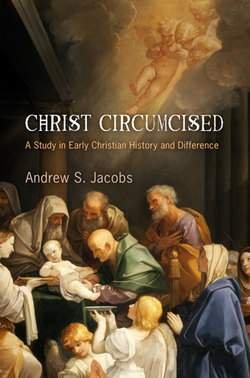Читать книгу Christ Circumcised - Andrew S. Jacobs - Страница 12
На сайте Литреса книга снята с продажи.
ОглавлениеChapter 3
Heresy, Theology, and the Divine Circumcision
The various means of purifying the abject—the various catharses—make up the history of religions.
—Julia Kristeva
Abject Heresy
In the fifth century, Vincentius of Lerins famously described Christian orthodoxy as “that which everywhere, always, and by everyone was believed.”1 Traditionally, we have understood Vincentius to be asserting the continuity of orthodoxy through time and space.2 Yet we might hear this claim to singular discourse differently within the political framework of the late Roman Empire. As I explained in Chapter 1, no overarching “Romanness” defined participation in the Roman Empire. Rather, the empire existed by virtue of its ability to contain and manage difference. Reading historically between Vincentius’s lines, then, we might hear him trumpeting not continuous assent stretching back to the time of the apostles, but rather a more fluid economy of doctrinal control patterned on the cultural economy of Roman authority.3 Orthodoxy literally comprises all manner of Christian belief, even that which it seems to reject.
In this chapter, I explore how the articulation of orthodoxy and heresy simultaneously asserted and negated Christian boundaries, visible through the variegated uses of Christ’s circumcision in theological debate. I argue that the logic of ancient Christian orthodoxy, despite its own rhetoric, was not a logic of the exclusion of the theological “other,” but a logic of the partial absorption and internalization of that “other.” As I lay out in the introduction, scholars treat Christian theological assertions of orthodox unanimity with a healthy skepticism: no longer do we believe that heresy constitutes deviation from a continuous line of orthodox truth stretching back to Jesus. Yet we remain drawn to models of binary self-definition, imagining that orthodoxy constitutes a “self” coming into being in direct relation to a heretical “other,” a figure of opposition identified (or constructed) to sharpen the boundaries of individual and communal identity.4 There are, however, other ways of tracing the curious and complex methods by which individuals and groups define “self” and “other,” models that may, in fact, fit better the fluid cultural economies of late Roman identity, and illumine the strategies by which orthodox Christianity likewise strove for dominance.
Whereas anthropologists and sociologists might view the formation of the “self” as a scene of definitive rejection of the “other,” psychoanalytic theorists like Julia Kristeva (drawing, ultimately, on Freud and Lacan) speak of abjection:5 a violent expulsion of “otherness” that is, by virtue of its very processes, always incomplete and recursive.6 Elizabeth Grosz comments on abjection: “The subject must disavow part of itself in order to gain a stable self, and this form of refusal marks whatever identity it acquires as provisional, and open to breakdown and instability.”7 For Kristeva, the abject can be any reminder of that incomplete disavowal, which gives the lie to bodily and subjective coherence: food, excrement, a cadaver.8 The abject is neither object (Other) nor subject (Self); it occupies an uncomfortable “in-between” space that challenges the boundaries of identity. To confront the abject—in Kristeva’s psychoanalytic terms—is to confront the impossibility of my-self, to return to a moment (horrifying or purifying) before “I” existed.
